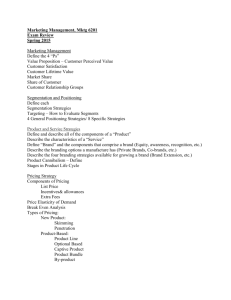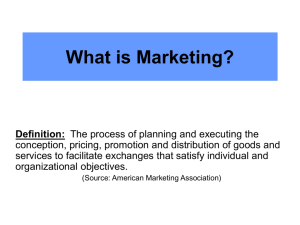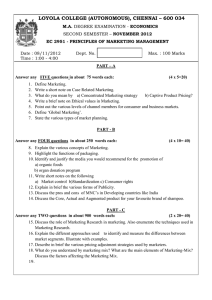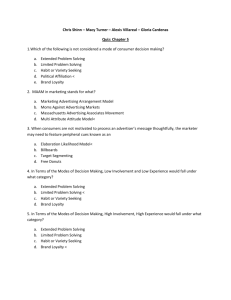REVIEW PACKET ANSWER KEY 2015
advertisement
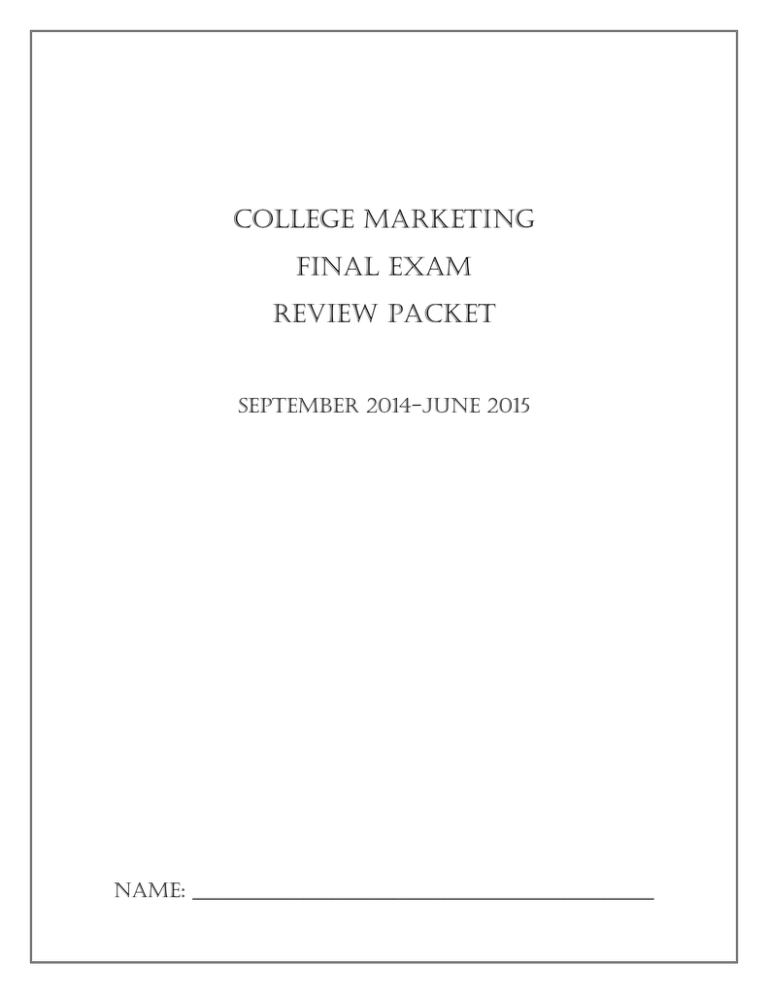
College Marketing Final exam Review packet September 2014-June 2015 Name: ______________________________________________ Introduction to Marketing 1. What is marketing? The process of developing, promoting, and distributing products to satisfy customer needs and wants. 2. What is the difference between a need and a want? 3. What is the difference between a good and a service? 4. What is utility? Want-satisfying power of a good or service 5. List and explain the four types of utility Form: Conversion of raw materials and components into finished goods and services Time: Availability of goods and services when consumers want them Place: Availability of goods and services at convenient locations. (Where customers want them) Ownership/Possession: Ability to transfer title of goods and services to buyer 6. What is marketing myopia? Marketing Myopia is management’s failure to recognize the scope of its business. 7. Describe the 5 Era’s of marketing history Era #1: Production Era i. Prior to the 1920’s ii. Attitude was that “A good product will sell itself.” iii. No effort made to market products Era #2: Sales Era i. 1920’s-1950’s ii. Customers resist non-essential goods and services iii. Personal Selling was prevalent iv. Advertising efforts tried to convince people to buy Era #3: Marketing Era i. 1950’s-1990’s ii. Satisfying customer needs is of utmost importance iii. “The customer is always right.” Era #4: Relationship Era i. 1990’s-Today ii. Focuses on establishing and maintaining relationships with both customers and suppliers iii. Involves long–term, value–added relationships Era #5: Social Marketing Era i. Concentrates on social interaction and a real-time connection with clients. ii. Businesses are connected to current and potential customers 24/7 and engagement is a critical success factor. 8. What are the 5 types of non-traditional marketing that were discussed in class? Explain each. What is person marketing? o Efforts to cultivate the attention, interest, and preferences of a target market toward a celebrity or authority figure What is place marketing? o Attempt to attract people and organizations to a particular geographic area. What is event marketing? o The marketing of sporting, cultural, and charitable activities to selected target markets What is cause marketing? 9. 10. 11. 12. 13. 14. 15. 16. 17. 18. 19. 20. 21. 22. 23. o Identification and marketing of a social issue, cause, or idea to selected target markets What is organization marketing? o Involves attempts to influence others to accept the goals of, receive the services of, or contribute in some way to an organization. Why is organization marketing sometimes viewed as controversial? Organizations tend to push their beliefs onto people and some will hound people for money/donations. What is the definition of an “image?” What is an endorsement? What is the difference between a customer and a consumer? What is the definition of a market? What is a target market? The group of people that you will base your marketing efforts towards. List 5 characteristics that marketers use to create their target market. Age Gender Income Family Status Ethnicity Occupation Location What is the difference between niche marketing and mass marketing? What is market segmentation? Marketers divide people into groups based on various shared characteristics. This allows marketers to concentrate on meeting the needs of certain types of buyers rather than the needs of all shoppers. List and explain the 4 categories of market segmentation. Demographics: The study of people’s vital statistics (Age, gender, income, ethnicity, education, religion, occupation, and family cycle.) Psychographics: Attitudes, interests, lifestyle, opinions, and social trends Geographic: Based on information regarding the places in which people live (Location, population, climate, area type) Behavioristics: Based on behavior, personality, and social class What is the definition of positioning? Positioning seeks to put a product in a certain position, or place, in the minds of prospective buyers. List and explain four ways in which a company can position themselves. Attributes: Associated with a benefit or product feature (bounty) Price/Quality Competitors (Avis) Application: Stresses the many uses of a product Product User Product Class What is repositioning and why is it difficult for a company to successfully reposition themselves? Repositioning is when a company tried to change how the consumers view the product. What is the purpose of the SWOT analysis? List and explain the three types of competition. Give an example of each one. Direct: Occurs among marketers of similar products Indirect: Products that are easily substituted for one another Universal: All organizations compete for consumer purchases Products 24. What is the difference between a product and a service? Tangible or intangible goods and services 25. List and explain the four main classifications of product. What are convenience products? Good or service that consumers want to purchase frequently, immediately, and with minimal effort. What are the three types of convenience products? o Impulse Products: Purchased on the spur of the moment. o Staples: Consumers constantly replenish to maintain a ready inventory. o Emergency Products: Purchased in response to unexpected and urgent needs. What are shopping products? Purchased only after the customer compares competing offers based on characteristics such as price, quality, style, and color What are specialty products? Good or service with unique characteristics that cause the buyer to value it and make a special effort to obtain it What are unsought products? Good or service marketed to consumers who may not yet recognized in the need for it 26. List and explain the three types of convenience products and give examples of each. 27. What is the product life cycle? Shows the progression of products through four distinct stages 28. List and explain the four stages of the product life cycle. Company works to stimulate demand for the new market entry Sales volume rises rapidly, Firm usually begins to make profits, Success attracts competitors Industry sales continue to grow, but eventually reach a plateau, Many competitors have entered the market, and profits began to decline Industry profits fall -- sometimes become losses 29. List three ways in which marketers try to extend the product life cycle. Increasing the frequency of use (anytime meal/fourth meal) Find new uses Change package sizes, labels, or product quality 30. What is the difference between “branding” and a “brand?” Branding is the process of creating that identity. Name, term, sign, symbol, design, or some combination that identifies the products of a firm while differentiating them from the competition’s. 31. List and explain the three levels of brand loyalty. Brand recognition: Consumer awareness and identification of a brand. Brand preference: Consumer reliance on previous experiences with a product to choose that product again. Brand insistence: Consumer refusals of alternatives and extensive search for desired merchandise. 32. List and explain the four types of brands discussed in class. 33. 34. 35. 36. 37. 38. 39. 40. 41. Generic Captive: brand names owned by stores that customers are aware of Private: Brand names owned by stores that customers are NOT aware of Why are generic products cheaper than brand name products? No money spend on branding/advertising What is a product line? A series of related products Why would a company want to create a product line instead of offer just 1 product? Money What is the difference between product width, length, and depth? Product Width--the number of product lines offered. Product Length--the number of different products a firm sells. Product Depth--variations in each product line that a firm markets in its mix. What is the definition of benchmarking? The process in which an organization improves performance by continually comparing and measuring itself against the leading firms in an industry and implementing changes for quality improvement What is the definition of market research? The process of collecting and using information for marketing decision-making. List and explain the two types of data that were discussed in class. Secondary Data: Information from previously published or compiled sources. Primary Data: Information collected for the first time specifically for a marketing research study. List and explain he four ways of collecting primary data. Survey Method Observation Method Focus Groups: Bring 8-12 people together to discuss a subject Experimental What are the three objectives of packaging a product? Protect against damage, pilferage, and spoilage Assistance in marketing the product Being cost effective Price 47. List and explain the three objectives of pricing. a. Profitability Objective: Objective is to make a profit, prices are set high although not sacrificing sales b. Volumes Objective: An objective in which the belief is that increased sales are most important in the long run than high profits. c. Prestige Objective: Established as relatively high price to establish and maintain an image of quality and exclusiveness 48. What is the definition of revenue? a. The amount of money that a company received in a given time period. 49. How do you calculate revenue? a. Revenue is calculated by multiplying the price at which goods or services are sold by the number of units or amount sold. 50. What is the definition of expenses? a. The total costs that a business incurs in a given time period. 51. How do you calculate profit? a. Revenue – Expenses = Profit 52. What is the definition of market share? a. The portion of the market that is controlled by a particular company or product. 53. How do you calculate market share? a. Market Share = (Total Company Sales/Total Industry Sales) x 100 54. What is penetration pricing? a. Price that is set when a product is new to the market b. Prices are set low to secure high sales 55. What types of products typically use penetration pricing? a. OMIT 56. What is market skimming? a. Main goal is to make a quick profit b. High prices with low sales volume 57. What types of products use market skimming? a. OMIT 58. What is a captive price? a. Premium pricing levels applied to components of a product that consumers have already purchased. 59. What types of product typically use captive pricing? a. OMIT 60. What is the definition of dynamic pricing? a. Price that changes with demand Promotion 61. List the 7 steps of the new product development process. a. SWOT Analysis b. Idea Generation c. Screening and Evaluation-Do we have the technology needed. d. Business Analysis-Do we have the finances-Do we need patents? e. Development-Prototype (First model) f. Test Marketing g. Commercialization 62. List the three objectives of packaging. a. Protect against damage, pilferage, and spoilage b. Assistance in marketing the product c. Being cost effective 63. What is personal Selling? What products are sold using this approach? a. When the sellers makes a promotional presentation face to face 64. What is the definition of advertising? a. Paid communication through various media which intends to inform, persuade, or remind members of a particular audience about a product, service, or business. 65. What is the definition of product placement? a. Form of promotion in which a marketer pays a motion picture or television program owner a fee to display a product prominently in the film or show. 66. List the three ways in which product placement can occur. a. It just happens b. Your product serves as compensation c. You can pay for it 67. What is the definition of sponsorships? a. When an organization provides funds to an event or activity in exchange for direct association with it. 68. What is ambush marketing? a. An attempt by a firm that is not an official sponsor of an event to link itself to that event. b. Ex: Samsung handed out t-shirts with their name on it at the olympics. 69. What is Guerilla Marketing? a. Any unconventional form of marketing 70. What are the two advantages to using Guerilla Marketing? a. Low Cost b. Stands out 71. What is viral marketing? a. When an add is viewed on the internet and the viewers pass the ad along so that it reaches a large sum of people. 72. Explain the AIDA concept. a. Attention b. Interest c. Desire d. Actions 73. List and explain the 6 message strategies that a company uses when advertising their products. a. Promote Brand Recall b. Persuade the customer c. Scare the consumer d. Induce anxiety e. Affective Association 74. What is an advertorial? a. An ad made to look like an article. 75. What are stakeholders? a. The groups or individuals who have an interest in the performance of the company or organization. 76. What are the two categories of stakeholders? (List two examples of stakeholders in each category.) a. Internal and external 77. What is the definition of public relations? a. A type of promotion intended to create goodwill for a person or institution 78. What is the difference between proactive and reactive public relations strategy? a. Proactive: Publicize a company and make them look good before anything bad happens b. Reactive: Considered damage control, fix an image that has just been tarnished 79. What is publicity? a. Advertising that is unplanned and disguised as news

